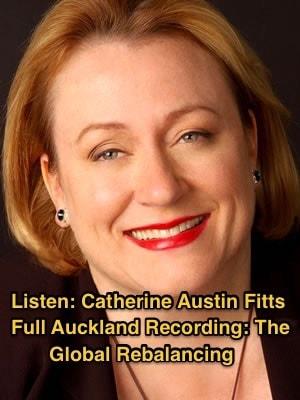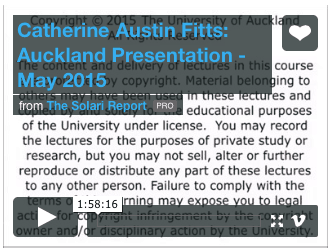Last week we gave you a quick summary of some of the points Catherine Austin Fitts covered in her presentation in Auckland two weekends ago and said we would give a full review this week.
Well we have something much better than that!
We’ve got permission to share the full recording of her presentation along with the excellent and lengthy Q&A session at the end.
In case you didn’t hear about it, Catherine Austin Fitts, publisher of The Solari Report, is a highly respected global economist who has challenged traditional thinking to expose flaws and inconsistencies in many of the prevailing policies and orthodoxies.
Her topic two Saturdays ago was The Global Rebalancing and was sponsored by the Ficino Educational Foundation, and held at the Business School of the University of Auckland.
You can listen to the full presentation, along with viewing Catherine’s slides as she speaks. There is plenty to take in and the Q&A session is particularly interesting. It is 1 hour and 58 minutes long and we highly recommend you make the time to listen.
Click the link below and scroll down to the embedded video.
https://solari.com/blog/the-global-rebalancing/
Some of What Catherine Austin Fitts Covered in Her Auckland Presentation
In case you didn’t read it last week (and want an indication of what is in store for you) here are a few of the points you’ll hear about in her talk. It focused on the Global rebalancing between the East and the West and the impact this will have:
She began with the fact that “According to the World Bank, the Chinese per capita income was $314 in 1990. The US per capita income was 76X greater, or $23,954. As of 2013, China per capital income had increased by 22X to $6,807, while the US had doubled to $53,042, or 8X the Chinese.”
So we seem to be steadily heading towards the east and the west reaching similar income levels. The unknown question is whether this happens by the West falling, the east rising or a combination of the two?
She noted that debt in the developing world has grown massively since 2008. China in particular has really gone nuts on debt.
The thing with a large part of this debt is that it is not denominated in the local currency. It is actually denominated in US dollars.
This in turns puts these developing economies at real risk even though this debt might be at low interest rates.
What risk is that?
US Dollar Bear Trap
She called it a “US Dollar bear trap”.
Most people expect the US dollar to continue weakening versus other currencies as it has in the long term.
But what if the Federal Reserve does in fact eventually raise interest rates? This would likely cause the US Dollar to skyrocket higher.
These developing nations would then need much more of their own dollars in order to repay their loans in a strengthening US dollar.
And unlike the US (having the world’s Reserve currency) they can’t simply print money in order to repay these debts.
As she said this it got us thinking what would a situation like this could mean for New Zealand?
Off the top of our head we think New Zealand still requires offshore funding for about 30% of our debt. (Sorry can’t locate the RBNZ data that confirms that right now.) We do recall this has fallen from over 40% pre GFC.
Nonetheless a “US Dollar Bear Trap” would likely make borrowing more expensive here too. Even if we have hedged and swapped and done other financial shenanigans if this offshore debt is not denominated in NZ dollars, at the very least our interest rates would have to rise sharply in order to attract the capital.
Much higher interest rates might not go down too well to anyone mortgaged up to the hilt.
Now Catherine wasn’t making a prediction here but it was food for thought nonetheless.
Positives Going For New Zealand
She did however also have a lot of positives to say about New Zealand’s position in this changing world. And said she’d rather be the NZ PM than the US president if given a choice.
We have a very literate population compared to many. And so we can adapt and re-engineer ourselves to cope with what might be rapid and significant changes ahead globally.
She coined a phrase from a Tina Turner song that “we can do this nice or do it rough”. Referring to the global rebalancing. We are a long way from anywhere else if things end up being “rough”.
Controlling oil prices have been the powers that be aim up until now. But Food control is what they are after now. Monsanto’s aim to control the seeds distribution shows this. So our primary industry is a real positive.
Global Digital Currency is the Aim
She believes a global digital currency is what “Mr Global” (her moniker for whoever is pulling the strings at the top) wants to achieve.
So there was certainly a lot to digest.
Head over to her Solari Report website and listen to it now!
Read more: RBNZ on Central Bank Digital Currency and Negative Interest Rates >>


